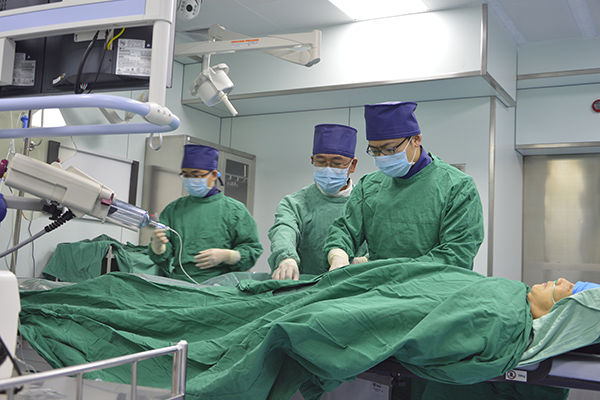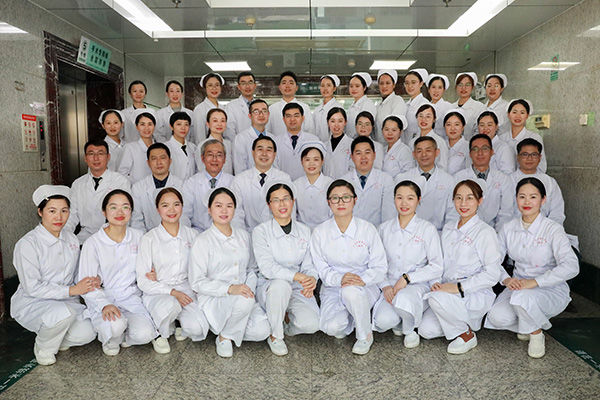This article is reprinted from: People’s Daily Online
From the hemiplegia of the right limb at the time of admission, to the gradual recovery of normal function and the improvement of the condition during the ward round the next day, the 88-year-old patient Mr. Li (pseudonym) and The family was overjoyed. For this, he and his family are very grateful to the cerebral infarction treatment team of the Second Affiliated Hospital of Guangxi University of Traditional Chinese Medicine (hereinafter referred to as “Guangxi Traditional Chinese Medicine”).
Recently, Mr. Li suffered a cerebral infarction at home. When he was sent to the emergency department of Guangxi Traditional Chinese Medicine by his family, Mr. Li had been unable to speak for two consecutive hours, and his right limb was obviously weak.
“Because the golden treatment time for cerebral infarction is 4.5 hours, patients with cerebral infarction can be given priority for various examinations such as CT, and emergency nurses will give priority to treatment.” Liu Yonghui, deputy director of the Second District of Guangzhou Traditional Chinese Medicine Encephalopathy According to the introduction, the hospital has opened a green channel for the treatment of cerebral infarction. When the emergency department finds a patient with cerebral infarction, it will immediately notify the cerebral infarction treatment team in the second area of encephalopathy, and conduct CT examination for the patient as soon as possible.

The cerebral infarction treatment team is undergoing interventional surgery. Photo by Liu Yonghui
After evaluation, the cerebral infarction treatment team gave Mr. Li intravenous thrombolytic drugs, and his symptoms improved slightly after the treatment. But for further improvement, interventional thrombectomy is necessary. During the operation, the doctor found that Mr. Li’s thrombosis was in a very thin blood vessel, and thrombectomy could not be performed. The doctor used intra-arterial medication to enhance the effect of thrombolysis. After the operation, Mr. Li’s symptoms improved significantly during the ward round the next day after admission.
A few days ago, the cerebral infarction treatment team also helped Mr. Lin, who suffers from chronic diseases such as hypertension and diabetes, through interventional surgery to remove a thrombus in his left vertebral artery, allowing Mr. Lin to recover his hands and feet. A state of free movement.
In recent years, under the background of aging, cerebral infarction has risen to the first cause of death in my country. stem these two diseases. With the development of medical technology, the methods of treatment are also constantly updated. Intravenous thrombolysis, interventional thrombectomy and other techniques implemented by the cerebral infarction treatment team are the most used technologies in the treatment of cerebral infarction patients in recent years, and they are also the most effective new technologies.
“Although our hospital is mainly based on traditional Chinese medicine, it will not fall behind the latest medical technology. Since its establishment, our cerebral infarction treatment team has formed a complete talent echelon, and the cerebral infarction treatment technology and domestic first-class The technical synchronization of the hospital will not leave patients with regrets due to technical reasons.” Liu Yonghui introduced.

The medical team of the second ward of the Department of Encephalopathy. Photo by Chen Kaiyun
It is understood that the Second District of TCM Encephalopathy in Guangxi is one of the medical, teaching and scientific research centers for TCM encephalopathy in the Yonggui area. It is a national key clinical specialty, a key specialty of the State Administration of Traditional Chinese Medicine, a key medical and health construction discipline in Guangxi, a key clinical specialty of the Guangxi Health and Family Planning Commission, and a key discipline of Guangxi University of Traditional Chinese Medicine. It is a stroke center under the China Stroke Center Alliance. The department currently has 130 open beds, and has two wards, Dongge and Xianhu (Xianhu ward has a neurointensive care unit).
In the past ten years, the department has focused on the development of sub-specialties such as cerebrovascular disease, severe neurological disease, vertigo, headache, and neuropsychology. In terms of cerebrovascular disease, the department has set up a cerebral infarction treatment team in the hospital, and gradually carried out early intravenous and arterial thrombolysis, sequential arteriovenous thrombolysis, mechanical thrombectomy, stenting of intracranial and intracranial cerebral vascular stenosis, Aneurysm packing and other treatment techniques.
At present, the cerebral infarction treatment team in the second district of encephalopathy has exported neurointerventional technology to many county and municipal traditional Chinese medicine hospitals in Guangxi, promoting the development of cerebral infarction treatment technology in Guangxi. (Ye Zhen and Lu Binbin)